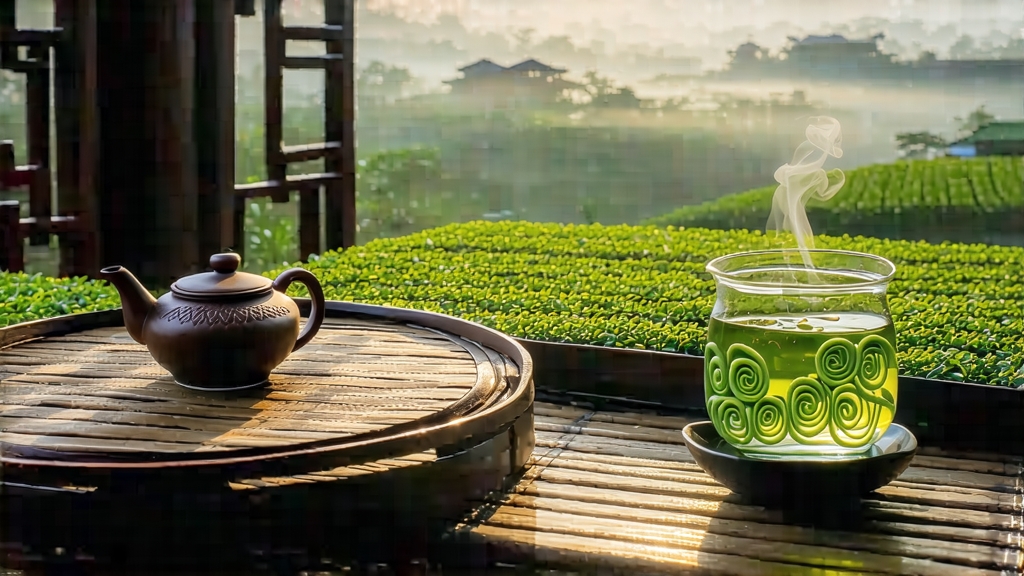
Among the jade-green pantheon of Chinese green teas, few names sound as lyrical as Biluochun—literally “Green Snail of Spring.” Grown on the mist-lapped hillsides that cradle Taihu Lake in Jiangsu province, this tea is prized for its tiny spiral-shaped leaves, downy silver tips, and a fragrance so delicate that connoisseurs say it carries the scent of both orchid and apricot blossom. To the uninitiated, Biluochun may look like a mere tangle of moss-green commas, yet each curl encapsulates six centuries of horticultural finesse, imperial legend, and microscopic attention to timing, temperature, and touch.
Historical whispers place Biluochun’s birth during the late Yuan dynasty, when a Taoist monk pruned wild tea shrubs that clung to Dongting Mountain’s rocky outcrops. By the Ming era, local chronicles already ranked it among “China’s Ten Famous Teas,” and the Kangxi Emperor (r. 1661-1722) is said to have renamed it on the spot after noticing how the tiny pellets resembled snail shells and how the infusion released an unmistakable spring vigor. Commerce soon followed fame: Suzhou tea brokers floated barrels across Taihu’s lotus-filled channels to the Grand Canal, feeding the appetites of scholars in Beijing and merchants as far south as Canton. Today, the original micro-terroirs—Dongting East and West Mountains—are protected by geographical indication status, and every April the lake’s morning fog still condenses on the same camellia sinensis cultivars, perpetuating a flavor that earlier poets described as “a liquid jade that sings of misty orchards.”
Although all Biluochun belongs to the green tea family, subtle clonal variations and micro-climates create three unofficial grades. “Supreme Early Bud” (Qianming) is plucked before Qingming festival from a single-leaf-and-bud set no longer than 2.5 cm; its liquor is almost colorless yet explosively floral. “Fine Spiral” (Teji) follows a week later, balancing sweetness with a greener, grassier edge. “Spring Snail” (Yiji) is harvested up to Guyu, offering a fuller body and a faint nutty finish appreciated by those who prefer a stronger cup. Regardless of grade, the leaf must be 100 % downy, uniformly curled, and free of any purple or yellow tips—imperfections that betray rushed plucking or mixed cultivars.
The crafting choreography begins the same night the buds are picked. Within four hours of harvest, trays of fragile leaves are spread beneath high-powered fans to reduce surface moisture; this “green-out” prevents premature oxidation that would dull the luminous jade color. Next comes the kill-green phase, unique among Chinese greens for its dual-temperature approach. Craftsmen tumble 250 g batches in a drum pan pre-heated to 180 °C for exactly 90 seconds—just long enough to rupture the cell walls and lock in the bright chlorophyll tone. The temperature then drops to 110 °C for the “first twist,” a four-minute hand-to-leaf massage that coaxes the bud to bend into its signature spiral. After a brief rest, the second twist occurs at 80 °C, during which masters flick their wrists in a figure-eight motion, rolling leaf against leaf until the silver hairs stand erect like minuscule barbs. Finally, a gentle 60 °C drying cycle reduces moisture to 5 % while preserving the volatile terpenes responsible for Biluochun’s hallmark aroma. Total processing time: 46 minutes, a window so narrow that villages schedule tea making around bus timetables to ensure every picker can deliver within the golden two-hour radius.
Brewing Biluochun is an exercise in restraint. Its cell structure is exceptionally delicate; water hotter than 80 °C will scald the downy hairs, releasing bitter catechins and muting the floral top notes. The classical Jiangsu method calls for a tall, cylindrical glass—not gaiwan—to showcase the “dancing spirals.” First, warm the glass with a quick swirl of 75 °C water and discard. Measure 3 g of tea (roughly one level teaspoon) for every 150 ml, then pour the water in a thin stream so that it hits the glass wall rather than the leaves directly. Within 30 seconds, the pellets unfurl like miniature ferns